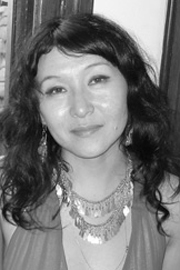Artist Spotlight: Almagul Menlibayeva
01.01.2017—
On occasion of her monumental installation “Transformation” custom-made for the Salon d'Honneur at the Grand Palais in
Paris, exhibited December to early January, the Tiroche DeLeon Collection is pleased to dedicate this spotlight to Almagul Menlibayeva.

Menlibayeva is one of the most well-known Central-Asian contemporary artists today. Born and raised in Kazakhstan, Menlibayeva currently lives and works between Almaty and Berlin. She received a Soviet Russian education and was trained as a painter at the Avant-Garde School of Futurism, a career she later pursued for several years. Although her paintings were very well received and awarded nationally with government prizes, she admits she was limited by her medium of choice, specifically in her ability to explore contemporary Kazakh identity. Menlibayeva then turned to photography and video art in order to better communicate the themes she was interested in exploring and reach a wider international audience, outside of her cultural context. After traveling to several of the world’s art capitals, Menlibayeva became aware of a tremendous underrepresentation of Central-Asian artists and subjects in the art-scene. As her artistic vision did not align with the expectations of neither Russian nor Asian artwork, she took it upon herself to expose the rich and unfamiliar cultures of Central-Asia through a new aesthetic, and thus began a cultural journey.
As a socially aware artist, Menlibayeva is most interested in highlighting the vast array of aspects and influences which comprise modern Kazakh identity, such as Shaman myths, rituals of Mongolian invaders, Islam, life in the Kazakh steppe and the region’s recent Soviet past. The richness and complexity of her culture is greatly evident in her work through her portrayal of the region’s landscape, her use of local subjects, and the depiction of traditional rituals and customs.
Today, her body of work possesses a unique nomadic aesthetic and language. For Menlibayeva, Kazakh culture is by definition a nomadic culture, one that is characterized by spontaneity, improvisation and practicality. This sensitivity comes across in her work, a unique artistic language not committed to any one tradition, but rather an eclectic display of themes and styles. Menlibayeva sees herself also as somewhat of a nomad, as she is constantly in transit, traveling with minimal belongings, specifically her necessary camera and computer.
Along with Menlibayeva's fascinating piece titled "Milk for Lamb" (2010), in 2012 the Tiroche DeLeon Collection acquired one of the artist's most acclaimed works, “Transoxiana Dreams” (2010), for which the artist received the prestigious Kino der Kunst award in 2013. The powerful piece is an experimental documentary which exposes the social, economic and ecological state of the vast region of the Aral Sea, referred to in the piece by its ancient name “Transoxiana,” which corresponds with modern-day southwest Kazakhstan. Menlibayeva reveals the current struggles of the Aralkum generation, the modern inhabitants of the desolate landscape. Due to the extreme irrigation policies of the Soviet Union, the people of Transoxiana live upon a rapidly growing salt desert.
Almagul Menlibayeva, "Transoxiana Dreams", 2010, High definition video single channel DVD
Edition: 3/5, 00:36
Menlibayeva's sophisticated fusion of documentary and fantasy generic qualities contributes to the work’s dreamlike aesthetic - a dream which portrays the efforts of the land's indigenous people to survive in the 21st century. Striking scenes of barren landscapes are punctuated by dramatic sound effects originating both from nature and machines. The film features frolicking children in the seemingly endless sandy desert playing with what can be interpreted as “obsolete technology” such as old wagon wheels and LP records. Like the children and the region, these are objects the world no longer sees use for - once a thriving area with tourism and fishing fleets, Transoxiana is now a dried-up wasteland. Despite the melancholic ambiance, a slight optimistic undertone lies in the children’s use of the objects. In spite of their struggles, they find value in what others see as obsolete. This can be seen as Menlibayeva's comment on the lack of representation of her culture in the contemporary art world. Like her subjects, she sees value and worth in what the western world conceives as “irrelevant”.
Almagul Menlibayeva, "Transoxiana Dreams", 2010, High definition video single channel DVD
Edition: 3/5, 00:46
Menlibayeva's art is widely acknowledged, receiving attention from such institutions as MoMA, New York, the Centre Georges Pompidou, Paris, and the Philadelphia Museum of Art. Her artworks were also acquired by the Louis Vuitton collection. She has gained international recognition exhibiting at the 4th Moscow Biennale of Contemporary Art; 10th Sharjah Biennial; 15th Sydney Biennial; 51st, 52nd and 53rd Venice Biennale; Museum van Hedendaagse Kunst, M HKA, Antwerp, Belgium; Queens Museum, NY; Herbert F. Johnson Museum, Ithaca, NY; Stenersen Museum, Oslo, Norway; University of California, San Diego, CA; Museo Universitario del Chopo, Mexico City; Queensland Art Gallery, Bisbane, Australia; and Chicago Cultural Center, Chicago, IL.
Menlibayeva's videos have been shown at the International Short Film Festival Winterthur, Switzerland; Sao Paulo International Short Film Festival, Brazil; Santiago International Film Festival, Chile; International Short Film Festival Oberhausen, Germany; International Film Festival Rotterdam, The Netherlands; Les Rencontres Internationales Paris/Berlin/Madrid; Centre Pompidou, Paris, France; and Palais de Tokyo, Paris, France; and Videonale 13, Kunstmuseum Bonn, Germany. In 2010, Menlibayeva was the recipient of a grant from the Open Society Institute Budapest, Art and Culture Network Program.
The Tiroche DeLeon Collection congratulates Alamgul Menlibayeva on her extraordinary installation in Paris and eagerly awaits to discover her future projects.
news archive
Art Vantage PCC Limited on Bloomberg
Sept. 1, 2013—We're proud to announce that the fund has been listed to Bloomberg
Read More »New - Quarterly Factsheet
Oct. 1, 2013—From now on, in addition to our regular newsletters we will publish a quarterly fund factsheet.
Read More »Manager Update - Q4 2018
Jan. 2, 2019—A quarterly update by Serge Tiroche about the state of the art market and activities of the Tiroche DeLeon Collection.
Read More »
.jpg)
.jpg)


